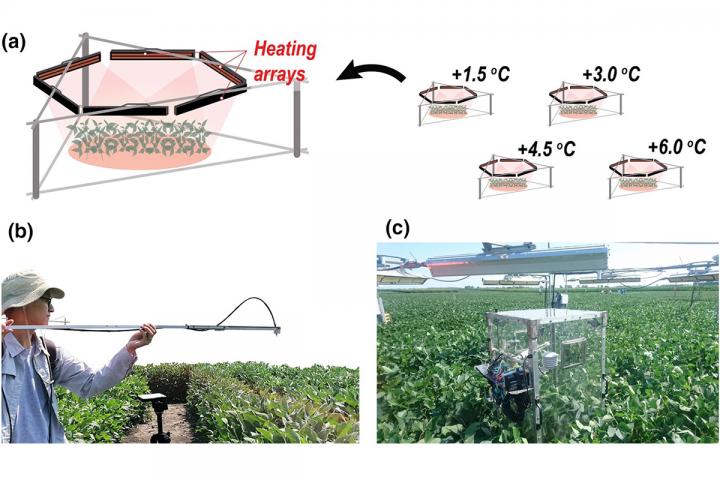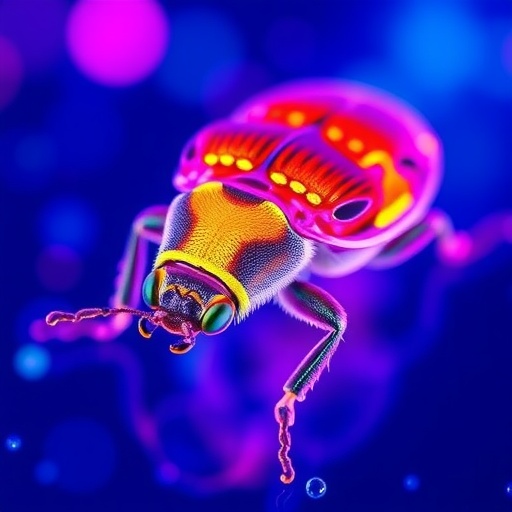
Credit: Graphic courtesy Hyungsuk Kimm
CHAMPAIGN, Ill. — Scientists report that it is possible to detect and predict heat damage in crops by measuring the fluorescent light signature of plant leaves experiencing heat stress. If collected via satellite, this fluorescent signal could support widespread monitoring of growth and crop yield under the heat stress of climate change, the researchers say.
Their study measures sun-induced chlorophyll fluorescence – or SIF – to monitor a plant’s photosynthetic health and establish a connection between heat stress and crop yield. The findings are published in the journal Global Change Biology.
Sun-induced chlorophyll fluorescence occurs when a portion of photosynthetic energy, in the form of near-infrared light, is emitted from plant leaves, the researchers said.
“There is a link between sun-induced chlorophyll fluorescence and photosynthetic rate in plants; however, it was unclear if SIF detection could measure physiological responses in heat-stressed plants,” said lead author Hyungsuk Kimm, a natural and resources and environmental sciences graduate student at the University of Illinois Urbana-Champaign. “When soybeans are exposed to high-temperature stress, for example, they do not show any distinctive changes in canopy structure, and conventional remote sensing signals do not provide clear consequential spectral signatures.”
To clarify the link between SIF and crop yield, researchers used a hyperspectral sensing system to measured SIF above soybean crops in the U. of I.’s Temperature Free-Air-Controlled Enhancement experimental plots in central Illinois. The setup monitored changes in chlorophyll fluorescence of soybean leaf canopies in a controlled environment using infrared lamps to raise temperatures 1.5, 3.0, 4.5, and 6.0 degrees Celsius above the ambient crop canopy temperature, the study reports.
“This experimental setup – and it’s a large temperature gradient – is the first of its kind,” said co-author Carl Bernacchi, a professor of plant biology and of crop sciences and a research scientist with the U.S. Department of Agriculture’s Agricultural Research Service at the U. of I.
“We found that sun-induced fluorescence responds to temperature increases and corresponds with fewer and lower quality soybean leaves,” said natural and resources and environmental sciences professor Kaiyu Guan, who directed the study. “We also found that heat stress has a great impact on soybeans during their reproductive stages when the plants are producing grain, which ultimately affects the size and quantity of the resulting soybeans.”
This study establishes a correlation between heat stress, SIF and grain quality and clarifies how heat stress affects photosynthetic performance and crop yield.
“The technique may provide a tool for breeders to identify more heat-resistant crops and help farmers select the best crops to grow in the U.S. Corn Belt as temperatures rise, as predicted by many climate models,” said co-author Lisa Ainsworth, a plant biology professor and U.S. Department of Agriculture scientist at Illinois.
###
Illinois researchers Charles Burroughs, Bin Peng, Caitlin Moore and Genghung Wu also participated in this research. The U.S. Department of Agriculture, NASA and the National Science Foundation supported this study.
Guan also is affiliated with the National Center for Supercomputing Applications and the Institute for Sustainability, Energy and Environment. Bernacchi and Ainsworth also are affiliated with the Carl R. Woese Institute for Genomic Biology. Guan, Ainsworth and Bernacchi are founding faculty members of the Agroecosystem Sustainability Center at Illinois.
Editor’s notes:
To reach Hyungsuk Kimm, call 217-979-8334, email [email protected].
To reach Kaiyu Guan, call 217-300-2690; [email protected].
The paper “Quantifying high-temperature stress on soybean canopy photosynthesis: the unique role of sun-induced chlorophyll fluorescence” is available online and from the U. of I. News Bureau. DOI: doi.org/10.1111/gcb.15603.
Media Contact
Lois Yoksoulian
[email protected]
Original Source
https:/
Related Journal Article
http://dx.





